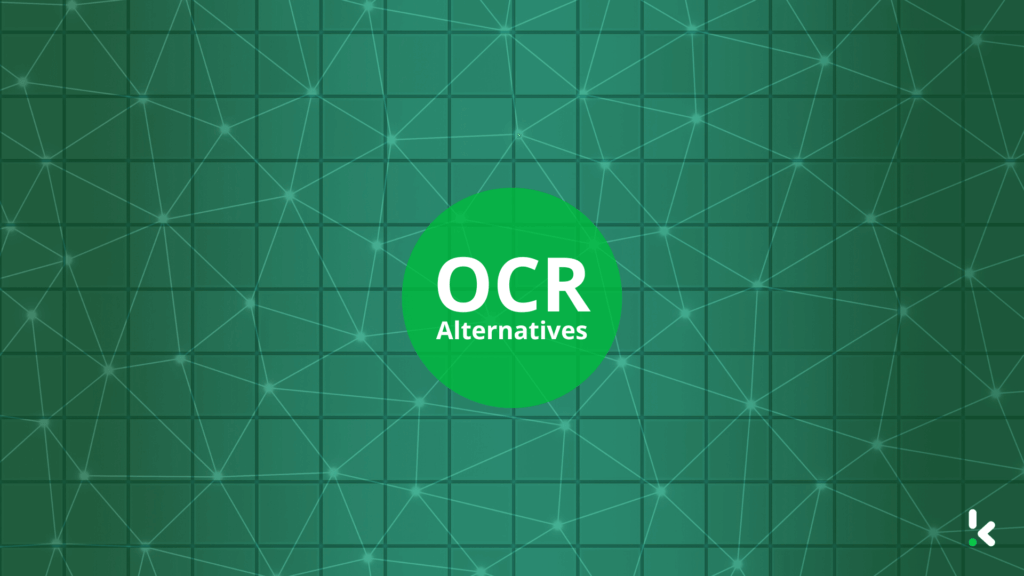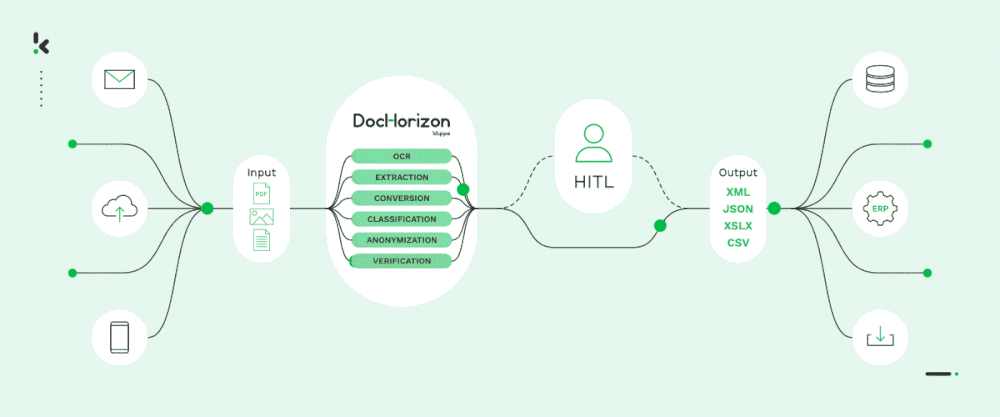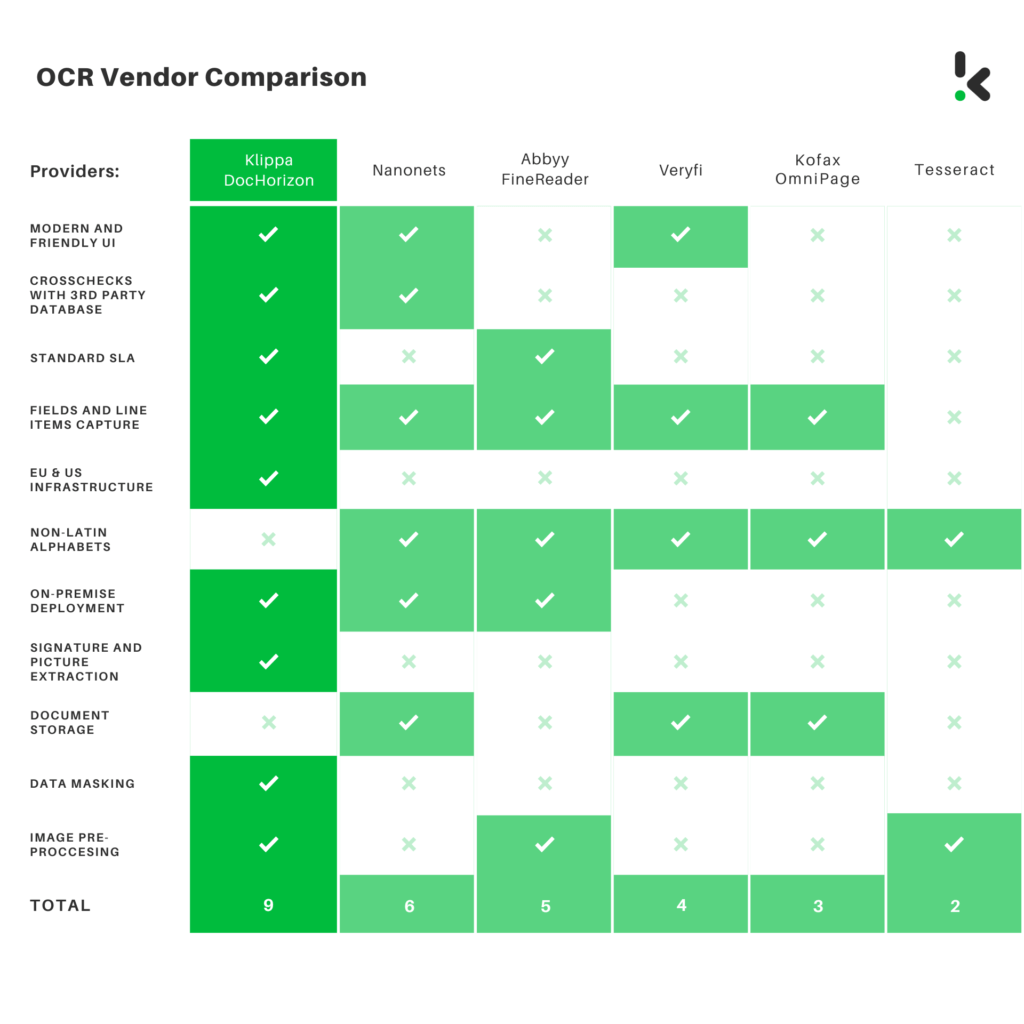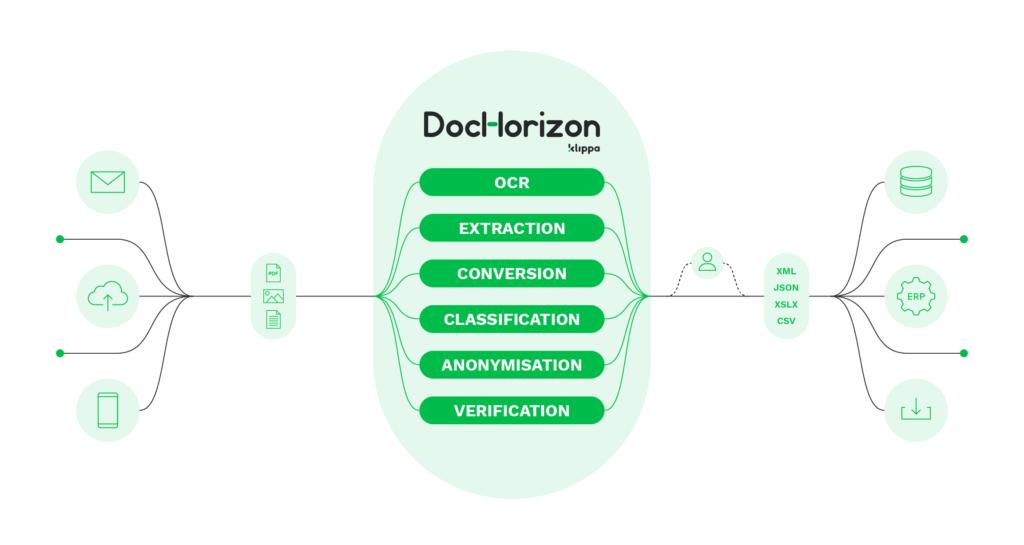

In this article, we will look into 5 alternatives to Nanonets. This AI-based OCR software helps companies extract data from images and documents, and converts them into searchable and machine-readable data.
Nanonets is a professional-level OCR software that succeeds in the market as a modern and functional solution for automating document-related processes. However, as with any software solution, it has its downsides.
For instance, with Nanonets, you need powerful high-end processors to maximize its capabilities. Also, it struggles with extracting line items from receipts and invoices accurately from time to time. But is there a better alternative?
To help you out, we have listed 5 alternatives to Nanonets. We will cover their functionalities, pros and cons, and their pricing. Hopefully, at the end of this article, you are ready to choose the best OCR provider for your organization.
Sounds good? Let’s get started!
1. Klippa DocHorizon


Klippa DocHorizon is an Intelligent Document Processing (IDP) solution that combines Optical Character Recognition (OCR) with advanced AI technologies. It is capable of scanning, classifying, anonymizing, extracting and verifying data.
This solution is primarily cloud-based, but on-premise deployment is also available.
Klippa DocHorizon helps businesses in multiple industries such as Accounting and ERP Software, Financial Services & Banking, Retail and Loyalty.
With Klippa DocHorizon you can submit documents via email, web or mobile apps. It will help you save up to 90% of your current manual processing time and allow you to save up to 60% of your budget, positively impacting your ROI!
With Klippa DocHorizon you can capture images, extract data, classify documents, anonymize sensitive data and convert documents into searchable files.
Pros of Klippa DocHorizon:
- Modern and Friendly UI
- Fields and line items capture
- EU and US Infrastructure
- Cloud and On-premise deployment
- Picture and signature extraction
- Data Masking
- Image preprocessing
- Standard SLA
- Send files anytime, anywhere
- Integrable via API or SDK to third-party applications
- Document and data classification
- Cross-check with 3rd party Database
Cons of Klippa DocHorizon:
- No support for Non-Latin Alphabets
- No Document Storage
Klippa DocHorizon is used in industries such as:
- Software and SaaS companies
- Logistics and transportation
- Legal
- Automotive
- Banking and Financial Services
- Retail
- Public Sector
- Courier, express and parcel services
- Marketing and Loyalty
- Travel industry
- Healthcare
- FMCG and CPG
- Customs
- Manufacturing
Klippa DocHorizon works best on document types such as:
- Financial documents (invoices, credit and debit cards, receipts)
- Identity documents (passports, driver’s licenses and ID cards)
- Legal documents (contracts, chamber of commerce and bylaws)
- Human resources documents (resumes, cartridges, etc.)
- Medical documents (health insurance cards, medical prescriptions)
- Logistics documents (bills of lading, CMR waybills and delivery notes)
Klippa DocHorizon Pricing:
Klippa works on a monthly subscription basis. Pricing depends on the volume of documents you are planning to process. The higher the volume of documents to be processed, the lower the price per document.
2. Veryfi
![]()
Veryfi is an OCR provider that helps companies to capture, extract and transform unstructured documents such as receipts, invoices, purchase orders and checks into structured data.
Like most OCR vendors, their software is used across multiple industries to reduce or eliminate manual data entry, avoid human error and unlock automation within the companies.
Pros of Veryfi:
- Modern UI
- Fields and line items capture
- Supports Non-Latin Alphabets
- Document Storage
Cons of Veryfi:
- No Cross Checks with 3rd party database
- No Standard SLA
- No On-premise deployment
- No Signature and picture extraction
- No Data Masking
Veryfi is used in industries such as:
- Logistics and transportation
- Retail
- Marketing and loyalty
- FMCG
Veryfi software works best on document types such as:
- Invoices
- Receipts
- Purchase orders
Veryfi pricing:
Veryfi offers a free trial, you can purchase the starter license for $500 /mo. And for enterprise, it is a customized price.
3. Tesseract
![]()
Tesseract is an open source OCR software that started back in 1985. Hewlett-Packard started its development as a commercial solution. In 2005 it became an open source project and since then Google has supported its development for several years.
Tesseract’s functionality is relatively limited because it works as a stand-alone package. It does one specific task, OCR, relatively well. But solutions to automate document processes have to be created by yourself.
Learn more about Tesseract OCR.
Pros of Tesseract:
- Free and open source alternative
- Supports Non-Latin Alphabets
- Image Preprocessing
Cons of Tesseract:
- It needs a lot of custom development
- Needs to be hosted and maintained in your own environment
- No Cross Checks with 3rd party database
- No Standard SLA
- No Signature and picture extraction
- No Data Masking
Tesseract is used in industries such as:
- Office and productivity
Tesseract software works best on document types such as:
- Invoice
- Purchase orders
- Income Receipts
- Tax forms
- Mortgage forms
Tesseract pricing:
Open source software, so it’s a free OCR alternative.
4. Tungsten (Kofax) OmniPage
![]()
Tungsten (prev. Kofax) Omnipage is an OCR software that can handle automation for high volumes of corporate PDF documents. This tool specializes in table extraction and line item matching.
Pros of Kofax OmniPage:
- Recognize over 120 languages during document processing.
- Use mobile scanners, desktop scanners, all-in-one printers and multifunction printers.
- Search, edit and access documents on any device.
- Fields and line items capture
- Document Storage
Cons of Kofax OmniPage:
- User interface could be better
- No Cross Checks with 3rd party database
- No European Infrastructure
- No On-premise deployment available
- No Signature and picture extraction capability
- No Data Masking
Kofax Omnipage is used in industries such as:
- Banking and finance.
- Marketing and loyalty
- Consumer Products
Kofax Omnipage software works best on document types such as:
- Invoices
- Receipts
- Purchase orders
Kofax OmniPage Pricing:
Kofax OmniPage Ultimate offers you a free trial to check out the features of this OCR tool. If you like it, you can purchase the individual license for $499.
5. Abbyy FineReader

Abbyy FineReader is an OCR software that digitizes, edits and shares documents, especially PDF files. It uses OCR to extract relevant information from different types of documents. Abbyy FineReader’s interface has a traditional look and feel as they have been in the market for a while.
Pros of Abbyy FineReader:
- Supports Non-Latin Alphabets
- On-premise deployment
- Create, edit, and organize PDFs
- Digitize paper documents
Cons of Abbyy FineReader:
- No Cross Checks with 3rd party database
- No Signature and picture extraction
- No Data Masking
- Difficult to customize
- Limited integration possibilities
Abbyy FineReader is used in industries such as:
- Legal service
- Education
- Public service
Abbyy FineReader software works best on document types such as:
- Invoice
- Purchase orders
- Income Receipts
- Tax forms
- Mortgage forms
Abbyy FineReader Pricing:
Abbyy FineReader software offers three packages:
- Standard: yearly subscription 117 € / year.
- Corporate: yearly subscription 165 € / year.
- Business: 1 and 3 year subscription plans are priced depending on the amount of files.
Comparing the different OCR software vendors
Finding the right OCR solution for your company can be complicated. Therefore, we recommend you to have a clear list of the needed features and functionalities.
To make it easier for you, we created an overview to compare the main differences and the features that can help you to pick the right OCR provider.


Why is Klippa DocHorizon the best alternative to Nanonets?
Klippa DocHorizon helps organizations around the world to automate document-related workflows. It is the one-stop solution for all your document automation needs, including an optional human in the loop.
The platform consists of several modules that can be used together or independently. It includes the following solutions:
- Mobile scanning – Scan documents from mobile devices at any place, any time.
- OCR – Turn documents into text and structured data formats.
- Data extraction – Real-time extraction of important data points.
- Classification – Classify and sort documents according to your needs.
- Document conversion – Turn JPG, PNG and PDF files to searchable text and export to formats like PDF or structured CSV, XLSX, XML and JSON.
- Anonymization – Mask sensitive data, from anonymization to removal.
- Verification – Verify the authenticity and validity of documents and data.


If you would like to know more about our DocHorizon solution, don’t hesitate to contact us. We are always happy to get in touch and answer all your questions. You can also schedule a free online demo below.